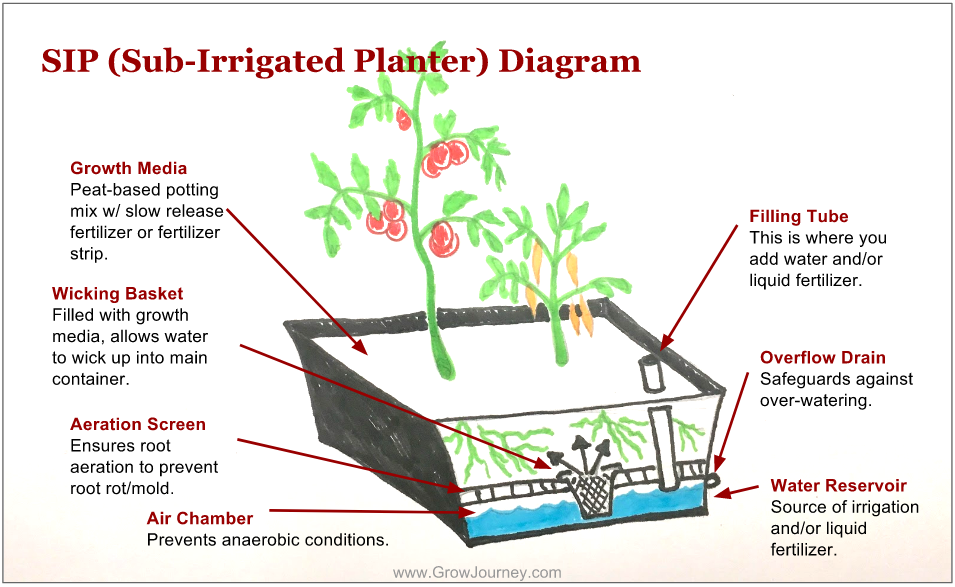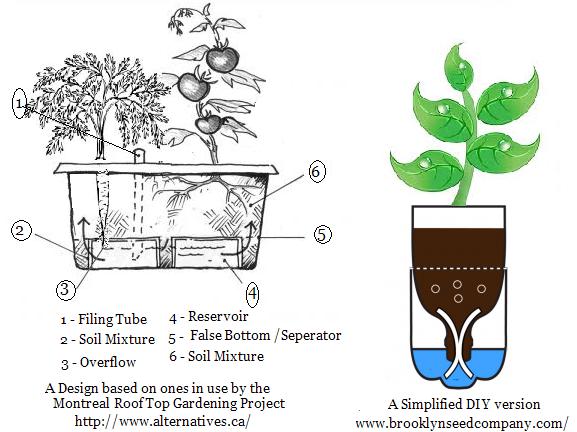Bottom watering is simply the practice of using an integrated watering tray to provide water to the plant from the bottom.
When a plant is submerged in water, a process known as capillary circulation causes the water to be drawn up by the plant throughout the soil.
We go over available bottom watering methods in this post, along with the benefits of starting to do so.
Table of Contents
What is a Bottom Watering System?
To uniformly disperse the water through the soil, bottom watering systems can be used to water a variety of plant sizes, from tiny plants like succulents to huge plants like monsteras.Â
Additionally, because it is straightforward and user-friendly, this kind of technology may be used anywhere.
With this technique, you merely pour water into the built-in tray and wait for it to finish.
The steps are the same as if the plant had been set into a tray of water.
The desired amount of water is naturally absorbed by the roots from the container. Typically, it takes 15 to 20 minutes to completely quench the plant’s thirst.
Since bottom watering allows you to prevent overwatering, underwatering, and the associated negative effects, this approach is essentially a hands-free way to water the plant.
What Are the Benefits of the Bottom Watering System?
The advantages of bottom watering are mostly associated with the development of plant roots, which is made possible by an even distribution of water throughout the soil.
I can promise you that the bottom watering method has several advantages, especially when it comes to watering little and medium-sized plants. Below are a few of them:
Growth of Plant Roots
Bottom watering is a fantastic way to encourage plant development.
The spread of the plant root and access to all the nutrients the soil may offer are stimulated as the soil’s entire structure becomes moist.
Bottom watering encourages appropriate root development and increases root strength, which benefits the plant’s ability to support itself both physically and nutritionally.
Prevent Overwatering
Overwatering and underwatering are the two most frequent issues that plants encounter. Some gardeners, especially novices, like watering their plants.
They will immediately add more water to the pot if the soil starts to seem dry. whereas some other gardeners don’t water their plants for years.
Bottom watering aids in the roots absorbing all the water they require from the soil.
For roughly three to four days, the soil is still damp. Which is advantageous for the absolute growth of plants.
This method of watering the plant prevents it from being either overwatered or underwatered.
Reduce Fungal Diseases and Plant Bugs
For house flies and gnats, a home with indoor plants is heaven. Many insects prefer to live in moist soil, which makes it their preferred habitat.
Fungi, algae, and soft roots are common food sources for fungus gnat larvae. Therefore, these delicately built bugs find the growing medium of houseplants to be their paradise.
Warm, wet topsoil is ideal for fungus gnats.
The growth of these fungus gnats can be considerably slowed down by bottom watering. Plants that receive bottom watering absorb the needed moisture through capillary action. Â
Unlike top watering, in which gardeners soak the topsoil,
In accordance with the requirements of the plants, bottom watering also results in a brief period of damp soil. You should water your plant from the bottom rather than the top if you want to get rid of bugs.
Prevent Root Rot
Root rot can occur for a variety of reasons. The root system’s poor performance, overwatering, and water logging from prolonged exposure to too much water are the main reasons.
By giving plants access to enough water, this issue can be resolved. You may ensure that the plant receives the necessary amount of water, not less or more, by using the bottom watering approach.
Additionally, bottom watering keeps the soil from becoming soggy and keeps the plant’s roots from rotting.
Nature of Plants
Wet leaves are completely unwelcome to some plants. Therefore, overwatering such plants may result in issues like leaf blight. Bottom watering is the best method for managing these plants.
More Uptake of Nutrients
Additionally, bottom watering maximizes nutrient uptake. Sulfur, nitrogen, and phosphorus are just a few of the nutrients that are beneficial for plant growth.
The roots can access all the nutrients in the soil when they are dispersed equally throughout the soil. The plant may greatly benefit nutritionally from this.
What is Bottom Watering?
Bottom watering is accomplished by setting the plant in a tray of water that is 1 to 2 inches high. Following this, the water is allowed to drain freely, leaving the soil moist and aerated. The water is subsequently absorbed into the soil from the bottom up.
Watering the bottom:
- It encourages the formation of strong roots
- It prevents gnats and other pests
- Overwatering is minimized.
- This enables the soil to breathe fresh air
Some Cool Bottom Watering System Planters:
You can shop on Amazon or at your local supermarket for a variety of cool bottom-watering pots.
We’ve listed a few of our personal favorites for bottom watering planters down below.
Self Watering Planter Pot:
Even when you are away from the house on vacation, you can bottom water your plants using this self-watering planter from Amazon.
Plants that have hollow legs and a deep reservoir can absorb moisture without having their roots drenched.
This wonderful planter has an easy irrigation system. It has drainage holes at the side of the planter where you may fill the large reservoir with water.
You won’t need to bother about purchasing an additional tray or tub to place your conventional planter in them for bottom watering if you use this planter.
Additionally, the linked reservoir will reduce the water sludge.
Wall Mountable Self Watering Planter Pots:
For bottom feeding small plants, use this charming and elegant Wall-mountable self-watering planter container.
Additionally, the planter pots have a practical bottom or a self-watering feature. Now you can water your little plants without having to move them around.
With these adorable yet useful planter pots, you can efficiently bottom water your favorite miniature plants, including as cactus and succulents.
Elongated Self-Watering Planter Pots:
This chic elongated self-watering planter pot is a great choice for use as a planter in a house, apartment, office, balcony, window sill, desktop, or other location.
You can preserve and bottom water two or three plants at once because to its distinctive design. It maintains plants’ moisture and health very effectively in addition to having a sophisticated appearance.
Self Watering Window Box Planter:
Another useful and attractive planter container for bottom-watering your plants is this window box planter.
The water reservoir in the planter is large and deep. It is composed entirely of premium polyethylene and is weatherproof.
You can keep bottom watering your plants for a long time without having to worry about buying new planters because to its 15-year warranty.
Bottom Watering Inserts:
Here are some helpful bottom watering inserts that will make taking care of your plants much easier for you:
Self Watering Plastic Planter with Water Level Indicator:
One of my favorite sleek and contemporary planters for bottom watering is the T4U 5.5 Inch Self Watering Plastic Planter. You can see when it has to be filled up again thanks to the water level indicator that is included.
I think it’s ideal for bottom watering tiny plants and herbs because it’s well made, stylish, contemporary, and affordable.
GroBucket Garden Kit (10PK) Self Watering sub-irrigated planter insert:
You can transform any regular bucket into a perfect bottom-watering planter using this incredible GroBucket kit.
Bottom Watering Plants When You Are Away:
Don’t worry if you need to go somewhere but are worried about your plants. You can skip days worth of watering your plants if you use any of the self-watering or cool-bottom containers mentioned above.
Your plants will remain hydrated in these planters for days without ever suffering root damage. The vegetation will continue to absorb water from the reservoir.
Enjoy your vacations without being concerned about your plants drying out.
FAQ
How do you fertilize a sub-irrigated planter?
It is simplest to incorporate fertilizer into the potting mix of your self-watering container. When preparing the container for planting, do this. Use granular fertilizer or slow-release fertilizer, which will allow the soil to absorb nutrients as it draws water from the reservoir.
What is the main benefit of a self-watering grow box?
An ongoing supply of moisture is provided to a plant in a self-watering pot, enabling the plant to flourish continually. Plants in self-watering containers are shielded from wind and temperature changes outside that could cause them to dry up too soon in between waterings.
Do self-watering planters cause root rot?
Some self-watering pots, like this one, lack an overflow opening: These self-watering pots are vulnerable to waterlogging and, thus, probable root damage if they lack a free-flowing drainage hole or an overflow hole.
Do self-watering planters actually work?
A “self-watering planter” doesn’t actually water itself, despite what the name suggests. But it enables you to water less frequently and offers a steady stream of moisture to the plants growing there.
Do self-watering planters cause root rot?
Some self-watering pots, like this one, lack an overflow opening: These self-watering pots are vulnerable to waterlogging and, thus, probable root damage if they lack a free-flowing drainage hole or an overflow hole.


